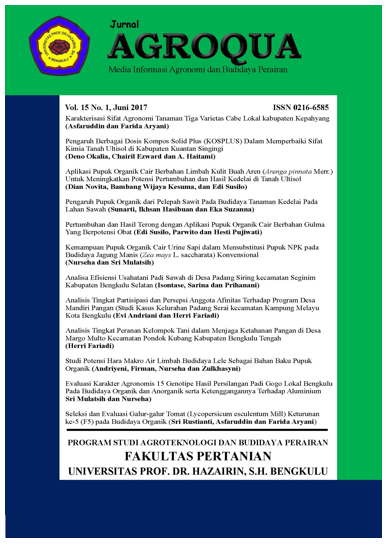PENGUJIAN JARAK TANAM DUA GALUR HASIL PERSILANGAN PADI GOGO LOKAL BENGKULU PADA PERTUMBUHAN DAN HASIL
DOI:
https://doi.org/10.32663/ja.v19i1.1796Keywords:
lines, planting distance, upland riceAbstract
This study aims to determine the right planting distance for the growth and results plant of local upland rice in Bengkulu, find the local upland Bengkulu rice lines that provide optimal growth and results, and find out the good planting distance for each Bengkulu upland rice lines for optimal growth and results. This study uses a Split Plot design inside RKAL two treatments and three replications. The main plot treatment of the two levels is lines UNHZ 31 and lines UNHZ 12. And three-stage plot treatment is planting distance 25 x 25 cm, planting distance 30 x 30 cm, and planting distance 35 x 35 cm. The results of the analysis of variance were continued with a significantly different test at the levels 5 % and 1 %. The parameters observed were plant height, the total number of tillers, panicle length, number of productive tillers, age of flowering 80 %, age of harvest, the weight of 100 grains, grain weight per clump, grain weight per plot, the weight of wet crop and weight of the dry crop. The results significantly affected grain weight per clump, wet crop weight, and dry crop weight. Significantly affected plant height 4 MST, 6 MST, 8 MST, 10 MST, post-harvest, total number of tillers 8 MST, 10 MST, and productive tillers. Not significantly affected plant height 2 MST, the total number of tillers 6 MST, panicle length, flowering age 80 %, harvest age, weight of 100 grains, and grain weight per plot. Treatment of 35 x 35 cm spacing and lines UNHZ 12 showed the best results on each observation but not cumulative.
Downloads
Published
Issue
Section
License
Authors who publish with this journal agree to the following terms:
- Authors grant the journal right of first publication with the work simultaneously licensed under a Creative Commons Attribution 4.0 Internasional (CC BY 4.0) Licence that allows others to use and share the work with an acknowledgment of the work's authorship and initial publication in this journal.
- The author(s) still hold the copyright of his/her/their work and retain publishing rights without restrictions such as (but not limited to) patent right, lecture, book and reproduce the article for own purposes.
















